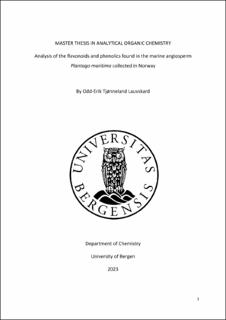Analysis of the flavonoids and phenolics found in the marine angiosperm Plantago maritima collected in Norway
Master thesis

View/
Date
2023-05-11Metadata
Show full item recordCollections
- Master theses [76]
Abstract
This master project has a focus on extraction, separation and identification of flavonoids and other phenolic compounds in Plantago maritima. Previously in Norway there has only been done one small pilot study (bachelor project in Jordheim group) on the phenolic compounds in this plant using only DAD-HPLC, so the Norwegian polyphenol profile of this species isn’t well documented. The polyphenolic profile of a species can show difference within geographical gradients due to different external parameters such as temperature, drought etc., normally this is seen for the quantitative amounts found. Qualitative polyphenolic profile variations are observed, however not to the same extent. Based on a literature survey, almost forty different polyphenols/phenolics are found in the genus in the classes of phenolic acids (cinnamic acid and hydroxybenzoic, and related esters), phenylethanoids and flavonoids. Both unsubstituted aglycones, mono and di-glycosylated compounds are seen. From literature ten polyphenols have been found in P. maritima: Caffeic acid (a), p-coumaric acid (b), ferulic acid (c), luteolin (14), chrysoeriol, diosmetin (17), apigenin-7-O-glucoside (2), luteolin-7-O-glucoside (3), verbascoside (10) and plantamajoside (1). In literature these ten compounds are confirmed through DAD-HPLC, ToF-MS (a, b, c, 14, 1 and 10) and MS/MS (2, 3 and 14). Plantago maritima samples were harvested in Tømmervågen (60.440802°N, 5.302253°E) Bergen 23.06.2019 and initial DAD-HPLC analysis was performed. Extraction was performed with aqueous methanol (60:40), and extracts were combined and evaporated. The crude extract was purified with XAD-7, and finally with preparative HPLC. The different stages of purity and fractions were analyzed with DAD-HPLC and LC-MS in negative ESI mode. Selected preparative HPLC fractions were run on NMR. In addition, crude and purified fractions have been extensively analyzed with DAD-HPLC (UV-Vis and retention time) and LR-LC-MS (including MS/MS on glycosylated flavonoids). A total of 18 phenolics were identified in Norwegian P. maritima. Only trace amounts were found from caffeic acid (a), p-coumaric acid (b) and ferulic acid (c). Plantamajoside (1) and luteolin (14) were confirmed with NMR (1D, 2D) analysis. These have previously only been tentatively identified in the species using HPLC, ToF-MS (1 and 14) and MS/MS (14). The flavonoid tricin (18), previously found only in P. phaeostoma, was identified with co - chromatography on HPLC and LC-MS using a tricin standard. A tricin glucoside (11) has also been identified (by LR-LC-MS and MS/MS) earlier found in P. crassifolia. Apigenin glucoside (2), luteolin 7 – O – glucoside (3), verbascoside (10) and diosmetin/chrysoeriol (17) were confirmed to be present (HPLC, LC-MS and MS/MS on 3 and 11). Ten compounds were for the first time in addition tentatively identified to be present within P. maritima: Campneoside I (4), nepitrin (6 – methoxy luteolin 7- glucoside) (6), luteolin glucuronide (7), quercetin arabinoside (8), tricin glucoside (11), rosmarinic acid (12), Apiin (apigenin 7 – apioglucoside) (13), martynoside (15), apigenin (16) tricin (18). (HPLC, LC-MS and MS/MS on 6, 7, 11 and 13). These have been found in the genus before by using DAD-HPLC, NMR (1, 3, 10, 11 and 15), TLC (12), MS/MS (1, 2, 4, 10, 14, 15, 16 and c), HR-MS (1, 2, 4, 10, 14, 15, 16 and c) In addition, two components tricin diglucoside (5) and diosmetin rutinoside (9) (HPLC, LC-MS and MS/MS on 5) were tentatively identified in both the species and in the genus for the first time.